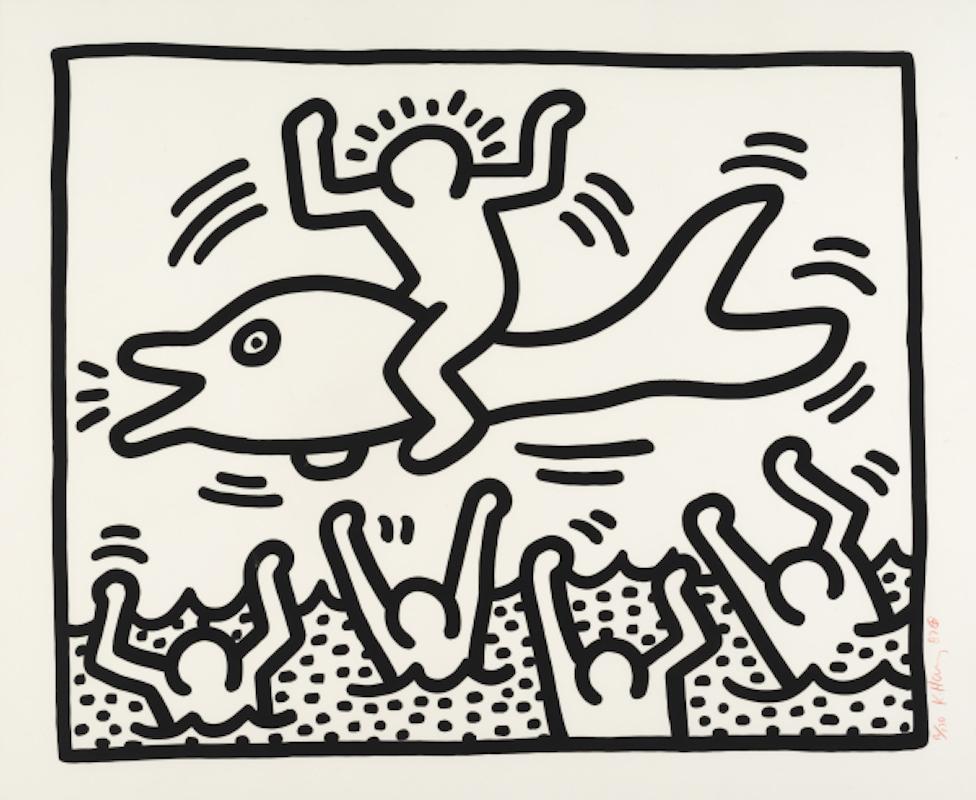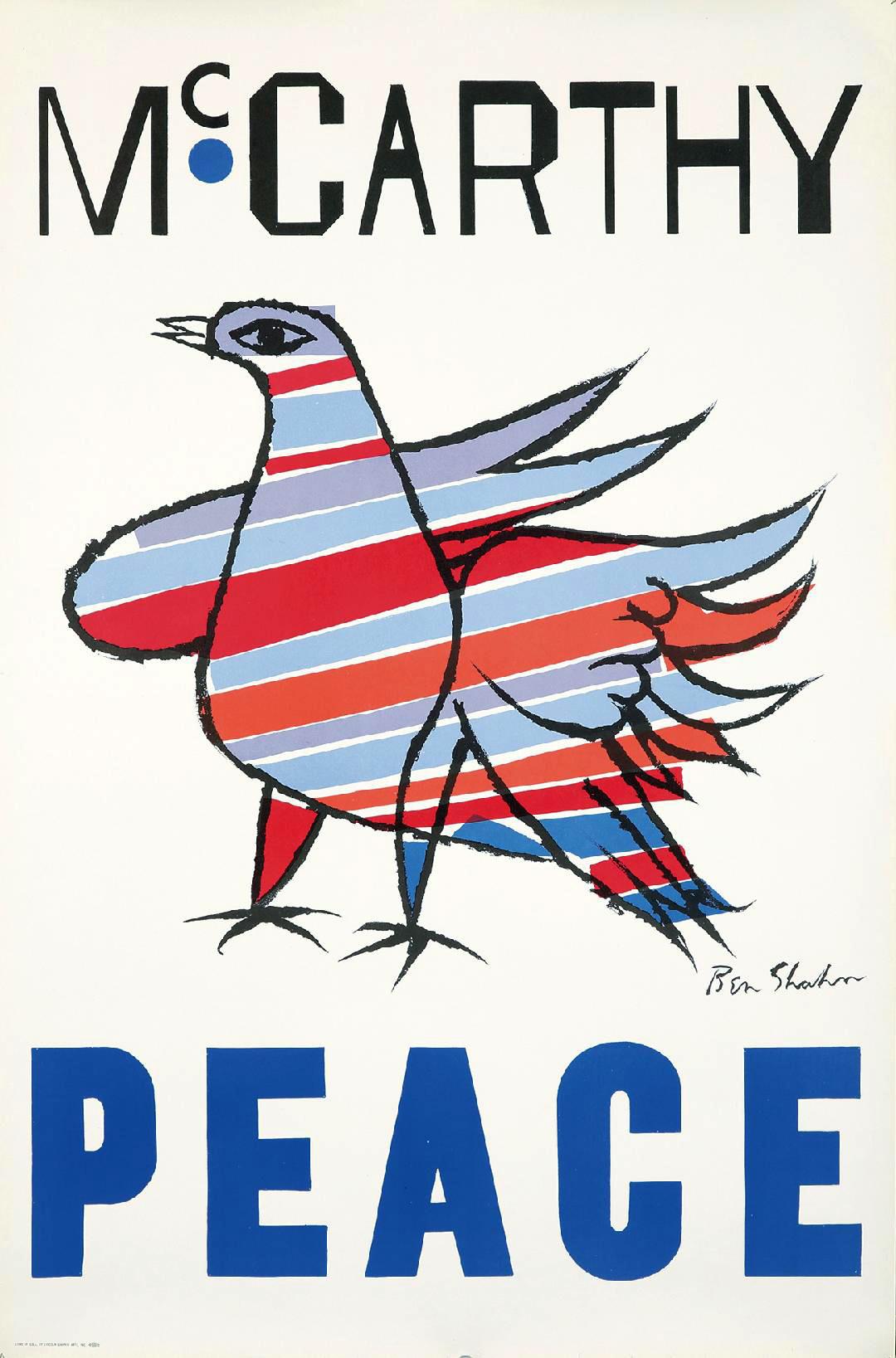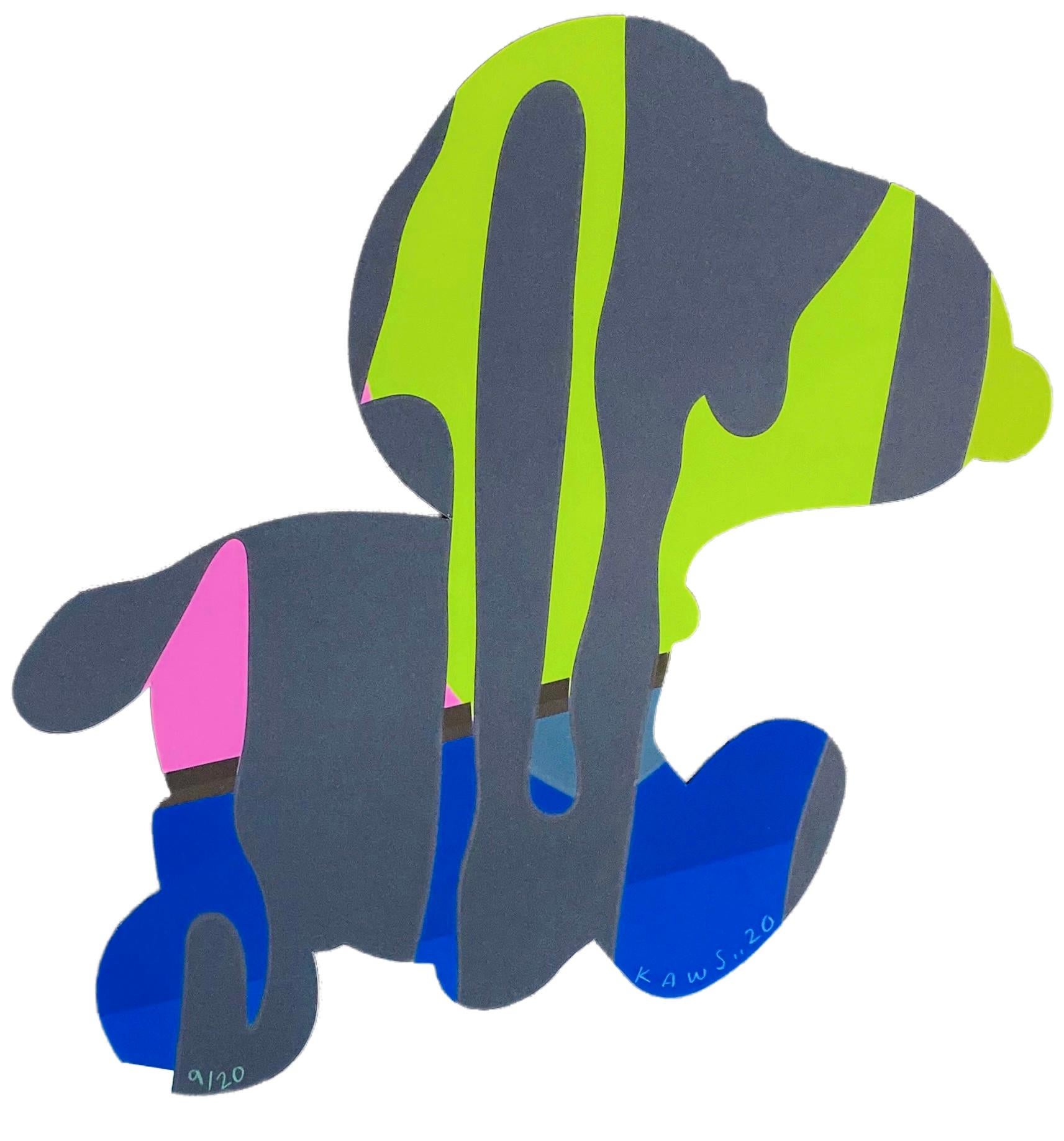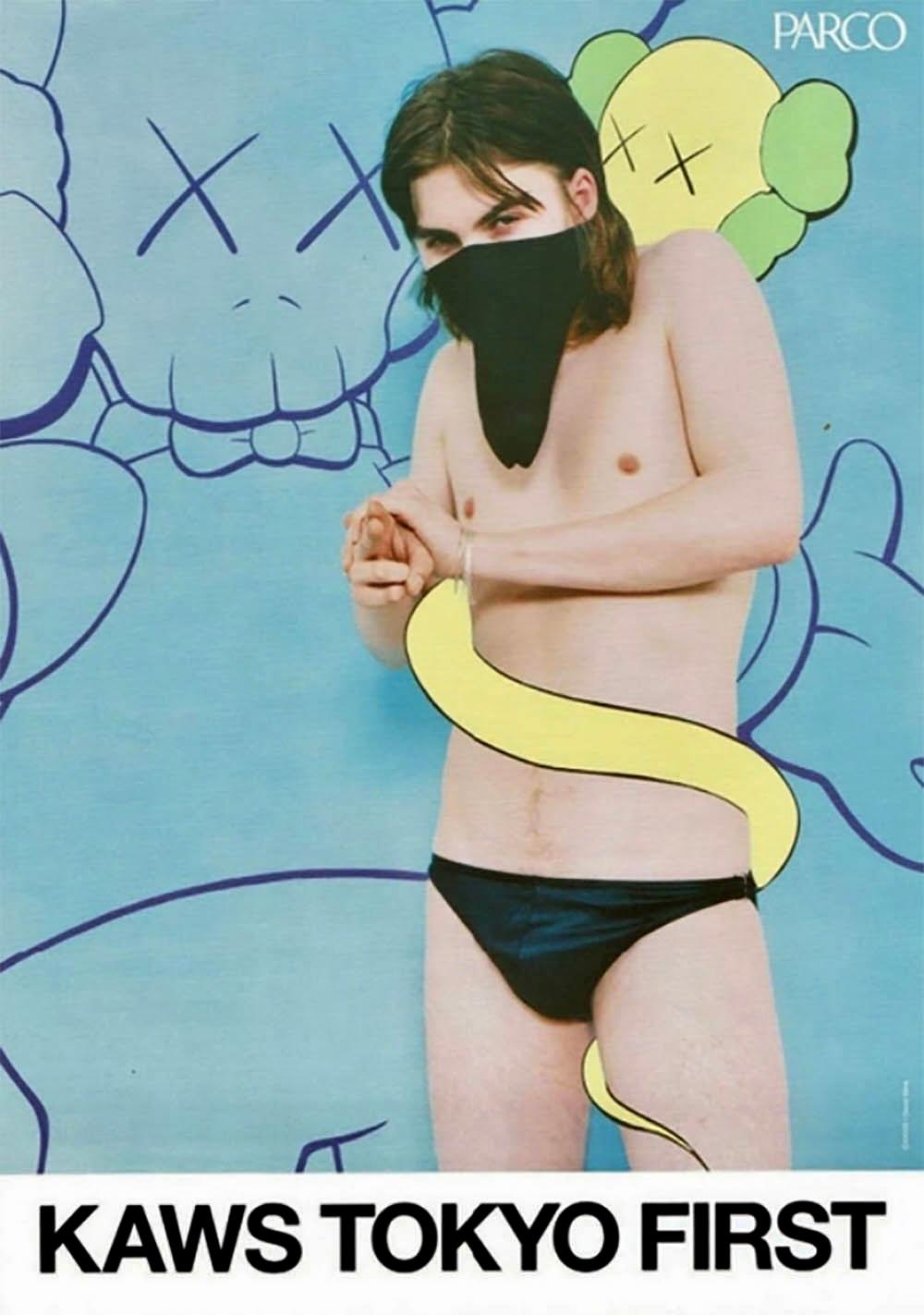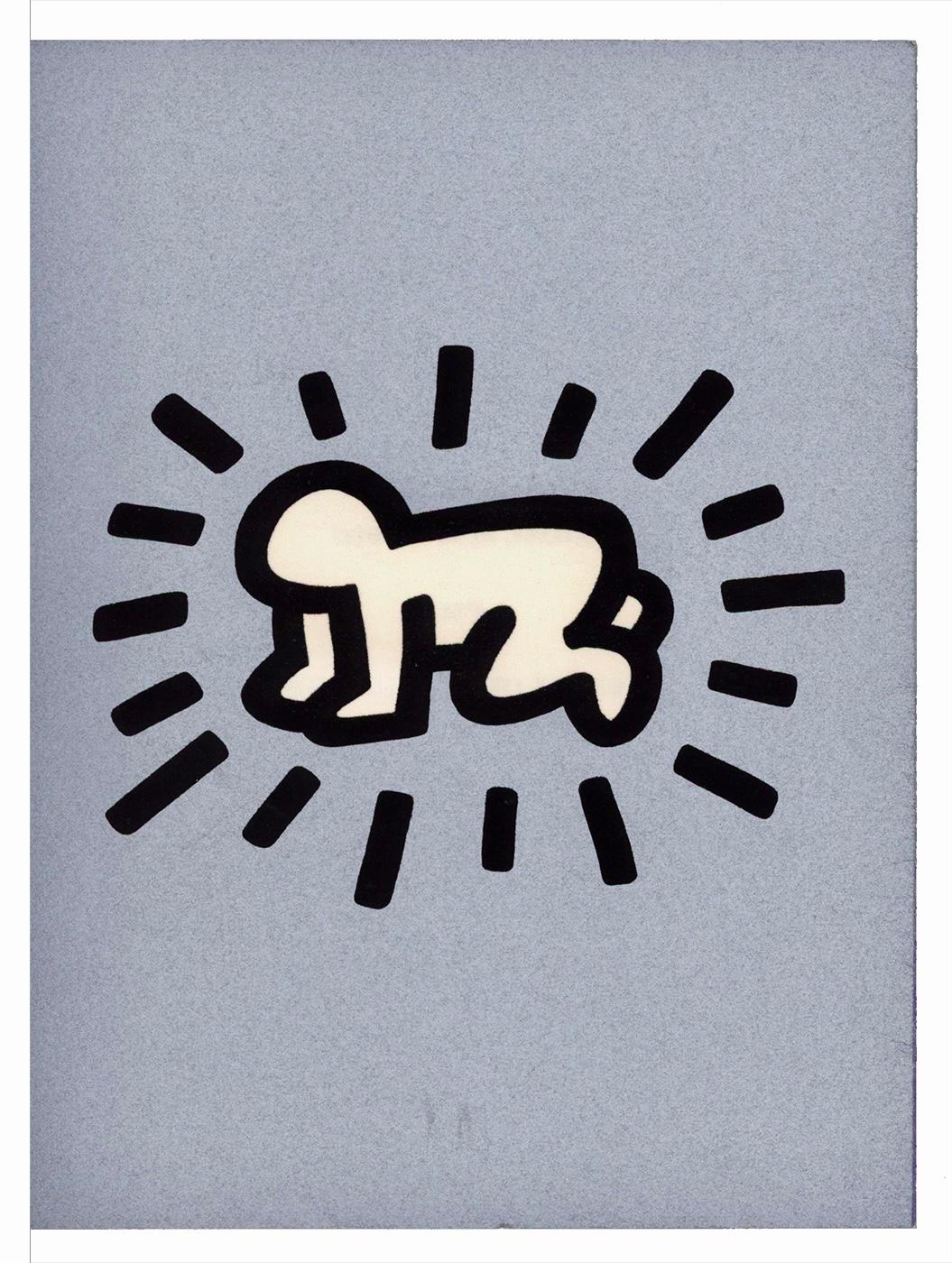Items Similar to Bird's Eye View
Want more images or videos?
Request additional images or videos from the seller
1 of 6
Ronnie CutroneBird's Eye View
About the Item
Ronnie Cutrone (1948-2013)
"Bird's Eye View" c. 1980s
Color Lithograph
Ed. 222/250
Signed, Numbered and Titled
Image Size: 17 x 23.5 inches
Framed Size: approx. 24 x 30 inches.
Ronnie Cutrone, a figurehead of the Pop and Post-Pop art scenes, was Andy Warhol's assistant at the Factory atop the Decker Building from 1972-1980, and worked closely with Roy Lichtenstein, combining stylistic elements of both. Cutrone's large-scale paintings of American cartoon icons, like Mickey Mouse, Felix the Cat, and Woody Woodpecker further reinvented kitsch and popular media in terms of fine art.
Executed in fluorescent monochromatic colors with the finesse of mass-produced silkscreen and prints, Cutrone's works are the reverse of tromp-l'oeil; they use fine art media (watercolor, pastel, crayon - on high-quality paper) to celebrate, rather than hide, the artifice of their subjects. "Everything is cartoon for me", Cutrone is noted for saying, even "ancient manuscripts…[they] are taken very seriously, but they are also cartoons."
Cutrone's works are exhibited and conserved in numerous galleries and museums worldwide, including the Whitney Museum; the MOMA (New York), the Museum of Contemporary Art (Los Angeles) and Museum Boijmans van Beuningen (Rotterdam).
- Creator:Ronnie Cutrone (1948 - 2013, American)
- Dimensions:Height: 24 in (60.96 cm)Width: 30 in (76.2 cm)Depth: 1 in (2.54 cm)
- Medium:
- Movement & Style:
- Period:
- Condition:
- Gallery Location:Missouri, MO
- Reference Number:1stDibs: LU74733551651
Ronnie Cutrone
Ronnie Cutrone was a Pop artist best known for his large scale paintings and drawings of America's cartoon characters, such as Felix the Cat, Pink Panther and Woody Woodpecker. As Andy Warhol's assistant at The Factory from 1972 to 1980, Warhol's most productive and prestigious years, Cutrone worked side by side with the Pop Master on paintings, prints, films, and concepts. It was during these years that he developed his own style that critics called Post-Pop. Cutrone's works have been exhibited at: The Whitney Museum - NY, The Museum of Modern Art - NY, Museum Boijmans Van Beuningen - Rotterdam, The Museum of contemporary Art - LA and numerous international fine art galleries.
About the Seller
5.0
Vetted Seller
These experienced sellers undergo a comprehensive evaluation by our team of in-house experts.
Established in 1970
1stDibs seller since 2017
142 sales on 1stDibs
Typical response time: 20 hours
- ShippingRetrieving quote...Ships From: Missouri, MO
- Return PolicyA return for this item may be initiated within 2 days of delivery.
More From This SellerView All
- Bareback Act, Old HippodromeBy Gifford BealLocated in Missouri, MOBareback Act, Old Hippodrome By Gifford Beal (1879-1956) Signed Lower Right Unframed: 6.5" x 9.5" Framed: 17.5" x 20" Gifford Beal, painter, etcher, muralist, and teacher, was born in New York City in 1879. The son of landscape painter William Reynolds Beal, Gifford Beal began studying at William Merritt Chase's Shinnecock School of Art (the first established school of plein air painting in America) at the age of thirteen, when he accompanied his older brother, Reynolds, to summer classes. He remained a pupil of Chase's for ten years also studying with him in New York City at the artist's private studio in the Tenth Street Studio Building. Later at his father's behest, he attended Princeton University from 1896 to 1900 while still continuing his lessons with Chase. Upon graduation from Princeton he took classes at the Art Students' League, studying with impressionist landscape painter Henry Ward Ranger and Boston academic painter Frank Vincent DuMond. He ended up as President of the Art Students League for fourteen years, "a distinction unsurpassed by any other artist." His student days were spent entirely in this country. "Given the opportunity to visit Paris en route to England in 1908, he chose to avoid it" he stated, "I didn't trust myself with the delightful life in ParisIt all sounded so fascinating and easy and loose." His subjects were predominately American, and it has been said stylistically "his art is completely American." Gifford achieved early recognition in the New York Art World. He became an associate member of the National Academy of Design in 1908 and was elected to full status of academician in 1914. He was known for garden parties, circuses, landscapes, streets, coasts, flowers and marines. This diversity in subject matter created "no typical or characteristic style to his work." Beal's style was highly influenced by Chase and Childe Hassam, a long time friend of the Beal family who used to travel "about the countryside with Beal in a car sketching...Category
20th Century American Modern Animal Prints
MaterialsLithograph
- Le Christ a l'Horloge, ParisBy Marc ChagallLocated in Missouri, MOMarc Chagall "Le Christ a l'Horloge, Paris" (Christ in the Clock) 1957 (M. 196) Color Lithograph on Arches Wove Paper Signed in Pencil "Marc Chagall" Lower Right Initialed "H.C." (Hors Commerce) Lower Left, aside from numbered edition of 90 *Floated in Gold Frame with Linen Matting, UV Plexiglass Sheet Size: 18 3/4 x 14 3/4 inches (47.5 cm x 38 cm) Image Size: 9 3/4 x 8 1/2 inches Framed Size: 28.5 x 24.25 inches Marc Chagall was a man of keen intelligence, a shrewd observer of the contemporary scene, with a great sympathy for human suffering. He was born on July 7, 1887 in Vitebsk, Russia; his original name was Moishe Shagal (Segal), but when he became a foremost member of the Ecole de Paris, he adopted French citizenship and the French spelling of his name. Vitebsk was a good-sized Russian town of over 60,000, not a shtetl. His father supported a wife and eight children as a worker in a herring-pickling plant. Sheltered by the Jewish commandment against graven images, the young Chagall never saw so much as a drawing until, one day, he watched a schoolmate copying a magazine illustration. He was ridiculed for his astonishment, but he began copying and improvising from magazines. Both Chagall's parents reluctantly agreed to let him study with Yehuda Pen, a Jewish artist in Vitebsk. Later, in 1906, they allowed their son to study in St. Petersburg, where he was exposed to Russian Iconography and folk art. At that time, Jews could leave the Pale only for business and employment and were required to carry a permit. Chagall, who was in St. Petersburg without a permit, was imprisoned briefly. His first wife, Bella Rosenfeld, was a product of a rich cultivated and intellectual group of Jews in Vitebsk. Chagall was made commissar for the arts for the area, charged with directing its cultural life and establishing an art school. Russian folklore, peasant life and landscapes persisted in his work all his life. In 1910 a rich patron, a lawyer named Vinaver, staked him to a crucial trip to Paris, where young artists were revolutionizing art. He also sent him a handsome allowance of 125 francs (in those days about $24) each month. Chagall rejected cubism, fauvism and futurism, but remained in Paris. He found a studio near Montparnasse in a famous twelve-sided wooden structure divided into wedge-shaped rooms. Chaim Soutine, a fellow Russian Jew, and Modigliani lived on the same floor. To Chagall's astonishment, he found himself heralded as one of the fathers of surrealism. In 1923, a delegation of Max Ernst, Paul Eluard and Gala (later Salvador Dali's wife) actually knelt before Chagall, begging him to join their ranks. He refused. To understand Chagall's work, it is necessary to know that he was born a Hasidic Jew, heir to mysticism and a world of the spirit, steeped in Jewish lore and reared in the Yiddish language. The Hasidim had a special feeling for animals, which they tried not to overburden. In the mysterious world of Kabbala and fantastic ancient legends of Chagall's youth, the imaginary was as important as the real. His extraordinary use of color also grew out of his dream world; he did not use color realistically, but for emotional effect and to serve the needs of his design. Most of his favorite themes, though superficially light and trivial, mask dark and somber thoughts. The circus he views as a mirror of life; the crucifixion as a tragic theme, used as a parallel to the historic Jewish condition, but he is perhaps best known for the rapturous lovers he painted all his life. His love of music is a theme that runs through his paintings. After a brief period in Berlin, Chagall, Bella and their young daughter, Ida, moved to Paris and in 1937 they assumed French citizenship. When France fell, Chagall accepted an invitation from the Museum of Modern Art to immigrate to the United States. He was arrested and imprisoned in Marseilles for a short time, but was still able to immigrate with his family. The Nazi onslaught caught Chagall in Vichy, France, preoccupied with his work. He was loath to leave; his friend Varian Fry rescued him from a police roundup of Jews in Marseille, and packed him, his family and 3500 lbs. of his art works on board a transatlantic ship. The day before he arrived in New York City, June 23, 1941, the Nazis attacked Russia. The United States provided a wartime haven and a climate of liberty for Chagall. In America he spent the war years designing large backdrops for the Ballet. Bella died suddenly in the United States of a viral infection in September 1944 while summering in upstate New York. He rushed her to a hospital in the Adirondacks, where, hampered by his fragmentary English, they were turned away with the excuse that the hour was too late. The next day she died. He waited for three years after the war before returning to France. With him went a slender married English girl, Virginia Haggard MacNeil; Chagall fell in love with her and they had a son, David. After seven years she ran off with an indigent photographer. It was an immense blow to Chagall's ego, but soon after, he met Valentine Brodsky, a Russian divorcee designing millinery in London (he called her Fava). She cared for him during the days of his immense fame and glory. They returned to France, to a home and studio in rustic Vence. Chagall loved the country and every day walked through the orchards, terraces, etc. before he went to work. Chagall died on March 28, 1985 in the south of France. His heirs negotiated an arrangement with the French state allowing them to pay most of their inheritance taxes in works of art. The heirs owed about $30 million to the French government; roughly $23 million of that amount was deemed payable in artworks. Chagall's daughter, Ida and his widow approved the arrangement. Written and submitted by Jean Ershler Schatz, artist and researcher from Laguna Woods, California. Sources: Hannah Grad Goodman in Homage to Chagall in Hadassah Magazine, June 1985 Jack Kroll in Newsweek, April 8, 1985 Andrea Jolles in National Jewish Monthly Magazine, May 1985 Michael Gibson...Category
1950s Modern Figurative Prints
MaterialsLithograph
- Hurry SundownBy Billy SchenckLocated in Missouri, MOBilly Schenck (American, b. 1947) Hurry Sundown, 1985 Edition 19/60 Serigraph 21 x 38 inches Signed, Titled, Dated, and Numbered Lower Margin Billy Schenck is a contemporary artist ...Category
1980s Pop Art Landscape Prints
MaterialsScreen
- Herring GullsBy Jamie WyethLocated in Missouri, MOJamie Wyeth "Herring Gulls" 1978 Color Lithograph Signed Lower Right Numbered Lower Left 149/300 Born in 1946, James Browning Wyeth came of age when the meaning of patriotism was clouded by the traumas of the Vietnam War and the scandals of Watergate. Working in an era of turmoil and questioning of governmental authority, he did art that encompassed both marching off to war and marching in protest. One of James's early masterworks, Draft Age (1965) depicts a childhood friend as a defiant Vietnam-era teenager resplendent in dark sunglasses and black leather jacket in a suitably insouciant pose. Two years later Wyeth painstakingly composed a haunting, posthumous Portrait of President John F. Kennedy (1967) that seems to catch the martyred Chief Executive in a moment of agonized indecision. As Wyeth Center curator Lauren Raye Smith points out, Wyeth "did not deify the slain president, [but] on the contrary made him seem almost too human." Based on hours of study and sketching of JFK's brothers Robert and Edward - documented by insightful studies in the exhibition - the final, pensive portrait seemed too realistic to family members and friends. "His brother Robert," writes Smith in the exhibition catalogue, "reportedly felt uneasy about this depiction, and said it reminded him of the President during the Bay of Pigs invasion." In spite of these misgivings, James's JFK likeness has been reproduced frequently and is one of the highlights of this show. The poignancy, appeal and perceptiveness of this portrait, painted when the youngest Wyeth was 21 years old, makes one wish he would do more portraits of important public figures. James himself feels he is at his best painting people he knows well, as exemplified by his vibrant Portrait of Jean Kennedy Smith (1972), which captures the vitality of the slain President's handsome sister. He did paint a portrait of Jimmy Carter for the January 1977 man-of-the-year cover of Time magazine, showing the casually dressed President-elect as a straightforward character posed under a flag-draped water tower next to the family peanut plant in Plains, Ga. James recalls that Carter had one Secret Service agent guarding him as he posed outdoors, a far cry from the protection our Chief Executives require today. As a participating artist in the "Eyewitness to Space" program organized by the National Aeronautics and Space Administration in collaboration with the National Gallery of Art in the late 1960s, Wyeth deftly recorded in a series of watercolors his eyewitness observations of dramatic spacecraft launchings and more mundane scenes associated with the space program. Commissioned by Harper's Magazine to cover the 1974 congressional hearings and trials of Watergate figures, James Wyeth executed a series of perceptive and now evocative sketches that recall those dark chapters in our history. Memorable images include a scowling John Ehrlichman, a hollow-eyed Bob Haldeman, an owlish Charles Colson, a focused Congressman Peter Rodino, a grim visaged Father/ Congressman Robert Drinan, and vignettes of the press and various courtroom activities. An 11-by-14-inch pencil sketch of the unflappable Judge John Sirica is especially well done. These "images are powerful as historical records," observes Smith, "and as lyrically journalistic impressions of events that changed the nation forever." Wyeth's sketch of early-morning crowds lined up outside the Supreme Court building hoping to hear the Watergate case, with the ubiquitous TV cameramen looking on, is reminiscent of recent scenes as the high court grappled with the Bush-Gore contest. The Wyeth family penchant for whimsy and enigmatic images is evident in Islanders (1990), showing two of James's friends, wearing goofy hats, sitting on the porch of a small Monhegan Island (Me.) cottage draped with a large American flag. Mixing the serious symbolism of Old Glory with the irreverent appearance of the two men, James has created a puzzling but interesting composition. Painting White House...Category
1970s American Modern Animal Prints
MaterialsPaper, Lithograph
- One of Their Pets (Two Farm Boys and Cow at the Watering Hole)By Joseph VorstLocated in Missouri, MOOne of Their Pets (Two Farm Boys and Cow at The Watering Hole) By Joseph Vorst (1897-1947) Signed Lower Right Edition 1/50 Lower Left Unframed: 8.5" x 11" Framed: 16" x 18.5" German-born Joseph Vorst came from Essen (born June 19, 1897). His teacher was the leading German impressionist Max Liebermann (1847-1935), who was the champion of French impressionism in Berlin. He had traveled to Barbizon and Paris to see paintings by Manet first hand, including In the Conservatory, which made its way to Berlin. Later Vorst's home town of Essen would acquire a collection of modern art in 1921, which became the Museum Folkwang, one of the earliest of its kind. Most likely to escape the Nazis, Vorst made his way to Missouri; we know that he was a member of the American Artists Congress and he signed the famous "Call" in 1936 at the group's first congress, the left-wing organization that stood up to combat fascism. Surely he would have known Joe Jones...Category
Early 20th Century American Realist Landscape Prints
MaterialsLithograph
- American Eagle (Nest Builder III)By Ted BlaylockLocated in Missouri, MOTed Blaylock (b. 1946) "Nest Builder III" 1986 Print Ed. 586/950 Signed and Numbered Ted Blaylock opened his own art studio and gallery in Collinsville, IL in 1969. He eventually mo...Category
1980s American Realist Animal Prints
MaterialsLithograph, Paper
You May Also Like
- UntitledBy Keith HaringLocated in New York, NYCreated by Keith Haring as an original lithograph, Untitled, 1987 is hand-signed, dated and numbered, measuring 29 ½ x 35 3/8 in (75 x 90 cm), unframed. From the edition of 170, it ...Category
20th Century Pop Art Animal Prints
MaterialsLithograph
- Milton Glaser Temple University Music Festival poster (Milton Glaser posters)By Milton GlaserLocated in NEW YORK, NYMilton Glaser Temple University Music Festival, 1975: Vintage original 1970s Milton Glaser poster designed by Milton Glaser on the occasion of the T...Category
1960s Pop Art Figurative Prints
MaterialsOffset, Lithograph
- Ben Shahn McCarthy PeaceBy Ben ShahnLocated in NEW YORK, NYBen Shahn McCarthy Peace poster, 1968. When Eugene McCarthy ran for U.S. president in 1968 against incumbent Lyndon Johnson, his candidacy was based on ...Category
1960s Pop Art Animal Prints
MaterialsLithograph
- KAWS print 2020 (KAWS snoopy print)By KAWSLocated in NEW YORK, NYKAWS Snoopy Print 2020: This rare, highly collectible KAWS Snoopy print was released on the occasion of the monumental 2021 KAWS Brooklyn Museum exhibitio...Category
21st Century and Contemporary Pop Art Animal Prints
MaterialsScreen, Lithograph
- KAWS exhibition poster 2001 (KAWS Tokyo 2001)By KAWSLocated in NEW YORK, NYKAWS Tokyo First Exhibit Poster 2001: 2001 KAWS Parco Gallery exhibition poster featuring a photograph by fashion photographer David Sims reimagined by KAWS in his classic 1990's interventionist style. A KAWS Kimpsons Krusty the Clown graces the background while a signature iconic KAWS Bendy wraps itself around the model. Reverse side features exhibition info from Parco Gallery, including Supreme and A Bathing Ape...Category
21st Century and Contemporary Pop Art Figurative Prints
MaterialsOffset, Lithograph
- Keith Haring 1990 memorial (Keith Haring baby)By (after) Keith HaringLocated in NEW YORK, NYKeith Haring Memorial 1990 (Keith Haring Baby, Keith Haring Barking Dog: Original screen-printed folding invitation with double-sided artwork publish...Category
1980s Pop Art Animal Prints
MaterialsLithograph, Screen
